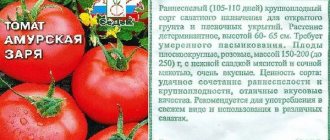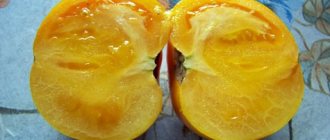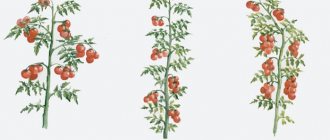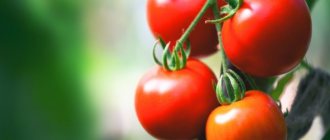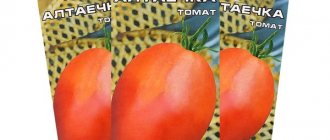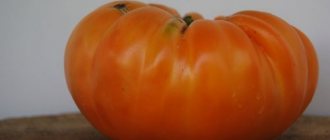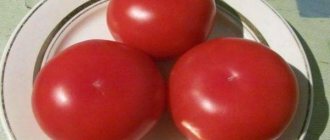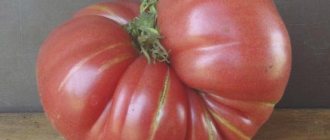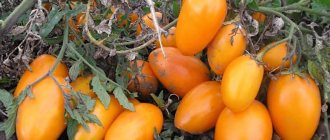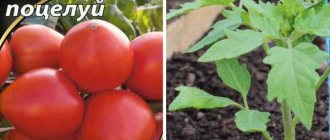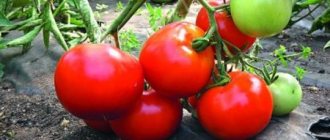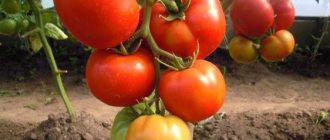Tomato Honey saved
Ripening period is mid-season (ripening period 110-115 days).
The bush is indeterminate (up to 1.8 m), weakly leafy, with drooping stems.
Salad. Designed for growing in open ground and under film covers.
The fruits are large (weighing 250-500 g), kidney-shaped, smooth, honey-yellow in color, juicy, sweet taste almost without acid.
The variety is high-yielding (up to 5 kg per bush), drought-resistant, extremely resistant to unfavorable growing conditions and diseases, but is demanding on soil quality. Plants require mandatory staking and shaping. The fruits do not crack, are well stored, and tolerate transportation well.
The best varieties of yellow tomatoes: top 25 most popular
Note! The list of the best yellow tomatoes was prepared based on the degree of popularity of the names of varieties and hybrids, analysis of reviews from experienced gardeners, as well as the personal opinion of the author.
The most popular and best varieties of yellow tomatoes can be called (alphabetically):
By the way! The most popular yellow varieties are the following (in order of popularity): Banana Legs and Persimmon are two big hits. Next in popularity are the Golden Heart, Honey Drop, Yellow Buyan and Honey Spas.
Altai orange
- Mid-season variety.
- The plant is indeterminate, up to 150 cm high.
- For open ground and film shelters.
- The fruit is bright orange, flat-round, slightly ribbed. The number of nests is more than 6.
- Weight - 250-500g.
- Productivity - up to 10 kg per sq.m (under film cover in a greenhouse).
- The fruits are dense, fleshy, and have excellent taste.
- Universal purpose: for fresh consumption and preparation of winter preparations.
- Withstands slight temperature fluctuations.
Amana Orange
- The variety is mid-early (110-120 days).
- The plant is indeterminate. The first inflorescence is formed above the 9th leaf, the subsequent ones - after 3 leaves.
- The fruits are orange, flat-round, with many pronounced ribs.
- Weight - 400-600 g (beef tomato).
- The taste is delicate, sweet, aromatic, with the presence of fruity notes.
- Resistant to the main range of tomato diseases.
- Productivity - 16-18 kg per sq.m.
Banana legs
The main hit of recent years in the category of yellow (orange) tomato varieties.
- The variety is ultra-early, from germination to harvesting the first harvest 90-96 days.
- The plant is semi-determinate. The first inflorescence is formed above the 9-11th leaf, the subsequent ones - after 2-3. It is advisable to form the plant into 2-3 stems, but the formation of up to 5 stems is acceptable.
- The fruits are two-chambered, cylindrical in shape with a tuberculate surface and a strongly elongated thin sharp nose, inclined to the side. The color is a rich yellow-orange color with yellow stripes, in which splashes of pink are noticeable.
- Weight - 50-80 g.
- Productivity - 5 kg per plant.
- The taste of the fruit is very good. The pulp melts in your mouth.
- Universal purpose: well suited for preparing a wide variety of dishes, canning and preparing tomato juice of unusual color.
- Resistant to major tomato diseases.
Buyan yellow
Sometimes the Buyan variety is called “ Fighter ”.
- Mid-season variety. It begins to bear fruit 110-115 days after germination.
- The plant is determinate, standard, strong, about 50 cm high.
- For open ground.
- The fruits are cylindrical, even, smooth, dense.
- Weight - 60-120 grams (up to 150 grams).
- Productivity - 2-5 kg per sq.m.
- The taste is pleasant (good or excellent), sweet with sourness.
- Mainly for fresh consumption, but also suitable for pickling.
- Tolerant to adverse weather conditions. The fruits ripen well and are stored well.
Cherry yellow
- Early ripening variety (92-96 days from germination to fruiting).
- The plant is indeterminate, semi-spreading, medium-branched, medium-leaved, more than 2 meters high. Form into one stem, removing all the “stepchildren”. The first inflorescence is laid above the 8-9 leaf, the subsequent ones - after 3 leaves. A long raceme with 20-40 fruits gives the plants a special decorative appearance.
- For cultivation in film greenhouses and open ground (with a garter to stakes).
- The fruits are round, smooth, and yellow in color.
- Weight - 15-20 g.
- Productivity - 1.0-2.0 kg per plant.
- Excellent sweet taste.
- Universal use: for fresh consumption, also suitable for canning with brushes.
- Susceptible to TMV and fusarium, highly susceptible to cladosporiosis.
Dina
- Mid-early (100-104 days) variety
- The plant is determinate, medium-branched, medium-leaved, 70 cm high. Requires moderate pinching. The first inflorescence is laid above the 6-7 leaf, the subsequent ones - after 1-2 leaves.
- For open ground and low film shelters.
- The fruits are round, smooth, orange. The number of nests is 4-5.
- Weight - 105-150 g (up to 300 grams).
- Productivity - up to 4.5 kg per sq.m.
- With excellent taste and high carotene content.
- Universal use: recommended for fresh consumption and processing.
- Resistant to septoria, moderately resistant to macrosporiosis, susceptible to late blight, watery and blossom end rot of fruits). Has good drought tolerance.
- Long fruiting period.
gold fish
- Medium late (111-120 days) variety.
- The plant is indeterminate, up to 1.8-2 m high. Requires pinching and staking. As a rule, it is formed into 1 stem.
- For film greenhouses and open ground (in the southern regions).
- The fruits are aligned, cylindrical with a “spout,” smooth, bright yellow-orange.
- Weight - up to 90-120 g.
- Productivity - 9 kg per sq.m.
- The taste is high. The pulp is dense, fleshy, with a high content of beta-carotene.
- Recommended for fresh consumption and whole-fruit canning.
- Resistant to adverse weather conditions. Weakly susceptible to late blight.
- Long-term fruiting.
Golden mother-in-law F1
- Early ripening hybrid (fruiting after 90 days).
- The plant is determinant, in a greenhouse it reaches a height of 1-1.5 meters, in open ground there is no need to plant it.
- For open ground and greenhouses.
- The fruits are leveled, round, smooth, intensely orange in color. The number of nests is 4 or more.
- Weight - up to 220 grams.
- Productivity - 4 kg per bush in a greenhouse (or 10 kg per square meter), 2.5 kg in open ground.
- The taste is good. With increased beta-carotene content.
- Universal use: for canning as a whole and for fresh consumption.
- Resistant to drought, tobacco mosaic virus, Alternaria and bacteriosis.
- The fruits are dense and do not crack.
The Golden Fleece
- Early ripening variety. Fruits in 85-98 days after full germination.
- For open and protected ground.
- The plant is determinate, 50-60 cm high.
- The fruits are elongated oval (ovoid), smooth, medium density, bright orange-yellow.
- Weight - 90-100 grams.
- Productivity 6-7 kg per sq.m (in a film greenhouse).
- High taste qualities.
- Universal purpose: for fresh consumption and whole-fruit canning.
- Resistant to a range of diseases.
Golden heart
- Ultra-early ripening variety (fruit ripening 80-85 days after full germination).
- The plant is determinate, the bush is strong, 30-40 cm high. Cluster with 5-7 fruits. Requires moderate pinching.
- For open ground and film shelters.
- The fruit is heart-shaped, slightly ribbed, orange. The number of nests is more than 4.
- Weight - 100-130 grams.
- Productivity - up to 7 kg per sq.m.
- Excellent taste. With increased beta-carotene content.
- Universal purpose: for fresh consumption and processing.
- Resistant to major crop diseases.
Golden Koenigsberg
- Mid-season variety (105-115 days).
- The plant is indeterminate, 1.5-1.8 m high (in a greenhouse), 1.2-1.5 m in open ground. It is characterized by good fruit set in a greenhouse. Inflorescences are formed through the leaf. On the hand up to 5-6.
- For greenhouses and film shelters.
- The fruits are oval-elongated, golden in color.
- Weight - up to 300 g, the first ones - up to 450 grams.
- Weight - 4.6-20.0 kg per sq.m.
- The fruits are very smooth, dense, have few seeds, and based on their taste and high carotene content, they can be called “Siberian apricots.”
- Perfect for fresh consumption and whole fruit canning.
- The variety is cold-resistant.
- During the fruiting period, the variety requires enhanced organo-mineral fertilizing.
Golden domes
- Mid-season variety.
- The plant is determinate, medium-sized, bush height is 90-150 cm. Requires staking and shaping. The first inflorescence is laid above the 8th leaf, the subsequent ones - after 1-2 leaves.
- For open ground and film greenhouses.
- The fruit is beautiful, rounded, heart-shaped, slightly ribbed, orange-yellow in color. The number of nests is 3-4.
- Weight - 400-800 grams.
- Productivity - 10.5-13.6 kg per sq.m.
- Meaty, juicy, delicious. Great for preparing salads and winter preparations.
- The fruits ripen well.
F1 paints
- Early ripening hybrid. From germination to the beginning of ripening 95 days.
- The plant is indeterminate. The first inflorescence forms above the 9th leaf, forming about 20 or more fruits in the cluster, depending on the structure - simple or complex.
- The fruits are round, two-chambered, richly yellow in biological ripeness, without a spot at the stalk.
- Weight - 20-25 g.
- Productivity - 3 kg per plant.
- Excellent taste, with uniform pulp density.
- Resistant to tomato mosaic virus, fusarium, cladosporiosis and verticillium.
Malachite Box
- Mid-early variety.
- The plant is indeterminate, up to 1.5 m high.
- For open and protected ground.
- The fruits are flat-round, large, emerald-yellow in color.
- Weight - 250-300 (maximum up to 900 g);
- Productivity - in open ground 4.3 kg per sq.m., under film covers - 15.1 kg per sq.m.
- The pulp is emerald green, delicate consistency with a melon flavor.
- The fruits are very fleshy and delicious in particular.
- Suitable for fresh consumption and home cooking.
Honey drop
- Mid-early variety (from germination to fruiting 100-110 days).
- The plant is indeterminate, tall, above 2 meters. Garter and shaping required.
- For cultivation in open ground and film greenhouses.
- The fruits are drop-shaped, smooth, honey-colored.
- Weight - up to 30 g (average 10-15 grams).
- Productivity - up to 5 kg per square meter. m.
- Pleasant sweetish taste, with a delicate tomato aroma.
- Universal purpose: for preparing delicious and bright fresh salads, pickles, marinades, delicious snacks and canapés.
Honey fingers F1
- Mid-season hybrid (95-105 days).
- The plant is indeterminate, 1.5-2 meters high. With honey clusters.
- For open and closed ground.
- The fruits are elongated-cylindrical with a spout. The color is honey pink with orange stripes.
- Weight - 70-80 grams.
- Productivity - up to 14 kg per sq.m.
- Excellent sweet and fruity taste.
- Universal purpose: can be eaten fresh, and also used for pickling and canning.
Honey giant
- Mid-season variety (from germination to ripening about 110-115 days).
- The plant is indeterminate.
- For cultivation in open ground and film greenhouses.
- The fruit is flat-round, ribbed, medium density, yellow-orange. The number of nests is 6 or more.
- Weight - 350-400 grams.
- Productivity - 7.5-8.0 kg per square meter under film covers.
- Very sweet, meaty, juicy, with wonderful aromas. Ideal for salads, but also suitable for light cooking.
- Resistant to cracking, tolerates transportation and storage well.
Honey saved
- Mid-season variety.
- The plant is indeterminate, usually 120-160 cm high (depending on growing conditions, higher in closed ground, lower in open ground). Formed into 1-2 stems with a garter to the support.
- For greenhouses and open ground.
- The fruits are large, kidney-shaped (round), warm honey-yellow in color. The number of nests is 4 or more.
- Weight - up to 600 g (on average - 150-250 g).
- Productivity - 4-5 kg per plant (average), or 5.6 kg per square meter in open ground, 14.0 kg per square meter under film covers.
- The pulp of tomatoes is very pleasant, sweet, almost without acid, and is useful for feeding people with diseases of the intestinal tract.
- Heat-resistant, transportable and resistant to unfavorable growing conditions.
Orange
- Early ripening variety (97-103 days from germination to fruiting).
- The plant is determinate, semi-spreading, medium-leaved, 35-40 cm high. Does not require shaping or tying. The first inflorescence is laid above the 6-7 leaf, the subsequent ones - after 1-2 leaves.
- For growing in open ground and under film covers.
- The fruit is flat-round, smooth, orange,
- Weight - 90-100 g,
- Productivity - 4.9-6.2 kg per sq.m.
- Universal purpose: for fresh consumption, preparing salads and whole-fruit canning. High in beta-carotene,
- Resistant to crown and root rot.
Orange heart
- Mid-season variety, the period from planting seedlings to fruiting is 85-90 days.
- For cultivation in film greenhouses.
- The plant is indeterminate.
- The fruit is heart-shaped, bright orange, slightly ribbed, of medium density.
- Weight - 180-200 grams.
- Productivity - 6.2 kg per sq.m.
- The taste is excellent, refined. Recommended for fresh consumption.
- The fruits retain commercial quality for a long time.
- Resistant to Alternaria leaf spot, cladosporiosis, tobacco mosaic virus.
Orange elephant
- Mid-season variety (110-120 days from germination to fruiting).
- The plant is determinate (with limited growth), medium-sized, 70-100 cm high.
- For cultivation in film greenhouses and open ground (in the southern regions) with a garter to stakes.
- The fruits are flat-round, bright orange,
- Weighing 250-300 g (individuals up to 500 grams).
- The pulp is tender, with a pleasant sweetish taste, and contains a lot of carotene.
- The fruits are perfect for making fresh summer salads, juices and tomato sauces.
- The variety is characterized by long-term fruiting.
Persimmon
- Mid-season variety. From germination to fruiting - 110-115 days.
- The plant is of a determinate type (with limited growth), heavily leafed, weakly branched, medium-sized, 70-100 cm high. The first inflorescence is formed above the 7th leaf, the subsequent ones - after 1-2 leaves.
- For growing in film greenhouses and open ground with a garter to stakes.
- The fruits are flat-round, golden-orange. The number of nests (chambers) is more than 4.
- Weight - up to 300 g (average - 240 grams).
- Productivity - up to 2-3 kg per plant or 5.8 kg per sq.m.
- Very pleasant taste. With tender and sweet flesh, contains a lot of beta-carotene.
- The fruits are perfect for preparing fresh summer salads (for dietary nutrition).
- It bears fruit for a long time.
Wonder of the world
- Mid-season variety (110-115 days).
- The plant is indeterminate. The first inflorescence is laid above the 11th leaf, the subsequent ones - after 3-5 leaves. As a rule, they are formed into 2-3 stems. There are up to 25 tomatoes in one brush, about 5 brushes in total.
- For open ground and film greenhouses.
- The fruits are bright yellow in color, regular oblong in shape, with a characteristic pointed nose, like a lemon. Number of nests - 2.
- Weight - 60-90 g (according to other sources, 50-70 grams).
- Productivity - 5.5-6.2 kg per sq.m.
- The taste is excellent, sugary. High in beta-carotene.
- Universal use: for salads and canning.
- Resistant to summer drought. Weakly affected by late blight.
Southern tan
- Mid-season variety.
- The plant is indeterminate, up to 1.7 meters high.
- For greenhouses and temporary shelters.
- The fruits are pepper-shaped and orange in color. Number of nests 4 or more.
- Weight - 150-350 grams.
- Productivity - up to 8 kg per bush.
- The fruits are fleshy and tasty, sweet, high in vitamins and low in acids.
- The fruits are dense, perfect for pickling and canning, and when fresh they are recommended for dietary nutrition.
Other varieties of yellow tomatoes
Naturally, there are a sufficient number of, albeit slightly less well-known, but quite good and proven varieties of yellow tomatoes, among which the following can also be distinguished:
- Large yellow zebra;
- Barrel of honey;
- The bull's heart is golden;
- Bull's heart is orange;
- De Barao gold;
- De Barao orange;
- Yellow Empire (new variety);
- Yellow scallops;
- Yellow Giant;
- Yellow Giant;
- Golden Canary;
- Golden Queen;
- America's Golden Heart;
- Golden Stream;
- Caramel yellow;
- Ray;
- Yellow marmalade;
- Honey pouring;
- Orange strawberry;
- Ryzhik;
- Siberian yellow;
- Yellow cream;
- Truffle yellow;
- Date yellow;
- Amber 530.
Over the years, the popularity of yellow and orange tomato varieties has not diminished. Now you have the opportunity to choose from a great variety the best ones, and most importantly, those that are suitable specifically for your greenhouse and/or garden plot. So, go ahead and buy some seeds at the store!
Video: the best varieties of yellow tomatoes
Tomato Golden fingers
Ripening period - mid-early (ripening period 90-100 days).
The bush is semi-determinate (up to 1.1 m), weakly leafy, forms few stepsons.
Universal purpose. Designed for growing in open ground and under film covers.
The fruits are small - cherry (weighing 15-30 g), elongated plum-shaped, smooth, yellow-orange in color, juicy, with dense pulp and skin, sweet taste.
The variety is high-yielding, light- and heat-loving, drought-resistant, extremely resistant to unfavorable growing conditions and diseases. Plants require minimal shaping. The fruits do not fall off for a long time, do not crack, are well stored, and tolerate transportation well.
The best choice for greenhouses
Pepper-shaped
The hybrid is not devoid of exoticism, but it is grown only in greenhouses. This is due to the fact that the variety is tall, the bushes cannot withstand the winds, and the stems break. The bright small fruits are shaped like an ellipse, and how delicious they are!
Date fruit
Our breeders developed small-fruited tomatoes. The taste is fruity. Summer residents of Central Russia recommend growing it indoors; the vegetables are heat-loving. The height of the bushes reaches one and a half meters.
The stems need to be tied up. Beautiful orange tomatoes ripen towards mid-June. Productivity depends on weather conditions. The hybrid successfully tolerates low temperatures, but the yield is significantly reduced. Dates can be grown right on the windowsill!
Tomato Amber Baltika
Ripening period is early ripening (ripening period 85-95 days).
The bush is short (up to 0.5 m), standard, with a thickened stem, well leafy.
Universal purpose. Designed for growing in open ground and under film covers.
The fruits are small (weighing 70-80 g), round in shape, smooth, amber-yellow in color, juicy, sweet taste.
The variety is medium-yielding (up to 3 kg per bush), unpretentious in cultivation, and is resistant to late blight. Plants do not require staking or pinching. The fruits are well stored and tolerate transportation well.
Tomato Persimmon
Ripening period is medium-late (ripening period 115-120 days).
The bush is determinate (up to 1 m), powerful, weakly branched, well leafy.
Universal purpose. Designed for growing in open ground and under film covers (where they grow higher).
The fruits are large (weighing 300-500 g), round, slightly flattened, smooth, glossy, bright orange in color, with hard skin and dense pulp, sweet taste.
The variety is high-yielding (up to 4-5 kg per bush), light-loving, and is distinguished by extended fruiting. Plants need staking and timely harvesting - overripe tomatoes become bland. The fruits do not crack, are stored well, and tolerate transportation well.
Tomato Ryzhik F1
Ripening period is mid-season (ripening period 100-108 days).
The bush is determinate (up to 1 m), medium branched, medium leafy.
Universal purpose. Designed for growing in open ground and under film covers.
The fruits are medium-sized (weighing 110-120 g), round in shape, smooth, yellow-orange in color, fleshy, sweet taste, almost without acid.
The hybrid is medium-yielding (up to 2.5 kg per bush), quite susceptible to cladosporiosis and fusarium, and resistant to late blight. Plants require obligatory staking, pinching and pinching. The fruits are well stored and can withstand transportation.
Tomato Yellow date F1
Ripening period – mid-early (ripening period 100-110 days).
The bush is semi-determinate (up to 1.5 m), weakly leafy.
Universal purpose. Designed for growing in open ground and under film covers.
The fruits are small - cherry (weighing 20 g), oval-plum-shaped, smooth, glossy, golden yellow in color, with dense pulp, juicy, sweet taste.
The hybrid is high-yielding, demanding on watering and fertilizing, resistant to most diseases, characterized by extended fruiting, the fruits set well and grow in clusters. Plants need pinching (up to the first cluster). The fruits do not crack, are well stored, and tolerate transportation well.
Distinctive features of yellow tomatoes
Yellow varieties of tomatoes have become widespread among gardeners not only for their original color, but also for their high benefits for the body. Experts believe that their consumption has a better effect on the body than their red-fruited relatives.
Among the beneficial properties of yellow tomatoes are:
- no allergic reaction to fruits;
- use in dietary and baby food;
- high lycopene content and antioxidant properties;
- improvement of blood composition;
- reducing the risk of cancer;
- high vitamin C content.
In addition to the beneficial properties, gardeners note that the fruits are sweeter and meatier. They delight the eye and lift the mood due to their bright colors, unusual shape and sugary taste. Yellow tomatoes are divided according to ripening time. They are actively used in decorating salads, slices, in preserves, and for making juice.
Tomato Honey Giant
Ripening period is mid-season (ripening period 110-115 days).
The bush is indeterminate (up to 1.9 m), medium leafy.
Universal purpose. Designed for growing in open ground and under film covers.
The fruits are large (weighing 300-400 g), round, slightly flattened, smooth, glossy, rich honey-yellow color, with fleshy pulp and thin dense skin, sweet taste, aromatic.
The variety is high-yielding (up to 5 kg per bush), resistant to most diseases, has extended fruiting, and is demanding on fertilizing. Plants need garter and supports. The fruits do not crack, are well stored, and tolerate transportation well.
Tomato Dina
Ripening period - mid-early (ripening period 100-105 days).
The bush is determinate (up to 0.9 m), medium branched, medium leafy.
Universal purpose. Designed for growing in open ground and under film covers.
The fruits are medium-sized (weighing 100-150 g), round in shape, smooth, golden yellow in color, with fleshy pulp and thin dense skin, with a sweet taste.
The variety is high-yielding, drought-resistant, resistant to most diseases (except late blight), has extended fruiting, and is undemanding to growing conditions. The fruits are smooth, do not crack, are well stored, and tolerate transportation well.
Yellow tomatoes
It was the yellow tomato that was first brought to Europe from the northwestern coast of South America. The word pomid'oro itself, borrowed through French from Italian, means “golden (yellow) apple,” so we brush aside doubts about the naturalness of yellow-fruited tomatoes (read about the varieties here ) once and for all!
Yellow tomatoes
Differences between yellow tomatoes and classic red ones
- lower acidity (because of this, yellow tomatoes are not the best option for preservation)
- softness of the vegetable
- less allergic
- less caloric
- more meaty, with less juice
- harvest season later
Taste of yellow tomatoes
From sweet (sometimes almost candy-like) to fruity.
Using yellow tomatoes in cooking
Yellow tomatoes are best eaten fresh. We recommend preparing salads , salsa, carpaccio and using it for cocktails, juices and vegetable smoothies.
Salad with broccoli, cherry tomatoes and oranges
